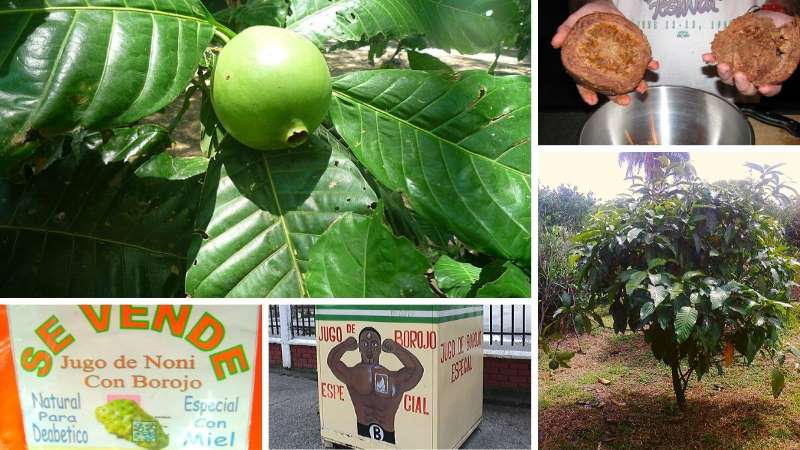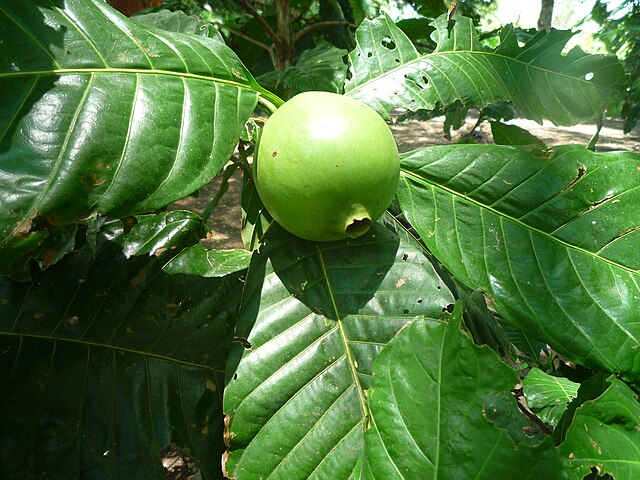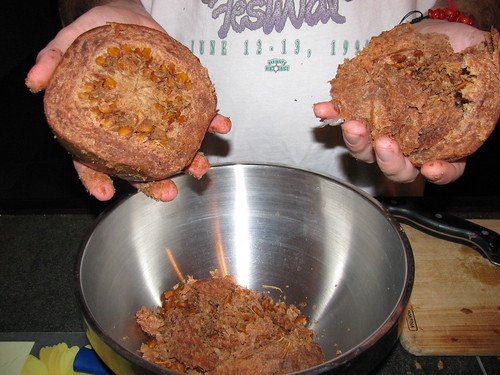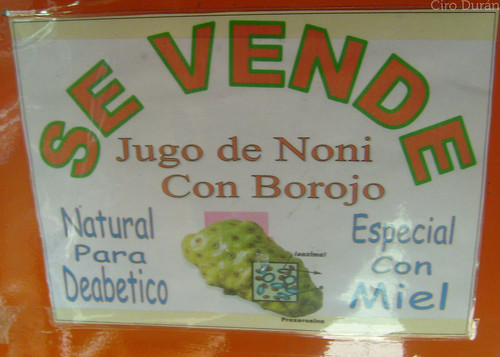
The borojo ( Barojoa patinoa Cuatr. ) is one of the many promising Amazonian fruits , there is no doubt about that. However, specialists discuss whether or not it is really rich in Vitamin C and polyphenols, which help fight cancer among other diseases. Aphrodisiac, invigorating properties are popularly attributed to it. Studies at least confirm that its phosphorus content is higher, apparently, than any other known fruit.
✅ Etymology: what does borojó mean?
Its name comes from the Embera language, spoken by the Embera ethnic group, which lives in the Colombian Pacific region, specifically in Chocó, in the Atrato River basin, and in some areas of eastern Panama and northwestern Ecuador . The term borojó is composed of two words: boro, head, and jo, fruit, which mean big-headed fruit. In Chocó they call it “the tree of the hanging heads”.
✅ Origin of the fruit
The borojó ( Barojoa patinoa Cuatr. ), a species baptized by Cuatrecasas in honor of the illustrious Colombian botanist VM Patiño, is native to South America, but the regional geographic origin has not yet been precisely determined.
The biogeographical Chocó is probably the original region of the borojó.
The Chocó, with 113,000 km2 of extension, is characterized by its location in tropical rainforests and Andean forests, and by its enormous biodiversity and high degree of endemism of species.
Although it is separated from the Amazon by the Andes mountain range, it nevertheless bears some similarities to the Amazonian forests.
The borojó plant is, perhaps, one of them, since some researchers such as Sotelo, Casas and Camelo (2010) maintain that it is also native to the Amazonian tropical rain forest.
✅ Amazonian borojó
A species of Amazonian borojo is mentioned, Duroia maguirei , a wild species up to 8 m tall. Or the species Borojoa sorbilis , but it may be a polymorphism of the same species that develops in different soils (Mosqueda, Moraga, Martínez-Navarrete 2010).
Burbano-Moreano (2015) points out, without clarifying the source, that in Panama there are two species similar to Borojoa patinoi : B. panamensis and B. atlantisensis , and that five species of borojó are found in the Brazilian Amazon .
✅ Botanical description of the plant
The borojó is a shrub or small tree, of the Rubiaceae family, with perennial leaves, decussate, of an intense green color, with an erect, woody stem, which grows, in the wild, from 3 to 4 or 5 m in height.

Male flowers in chapters, and female terminal and solitary.
It is a cross- pollinated plant.
It grows well in areas up to 800 meters above sea level, and at an average temperature of 24 to 28 °C.
Its fruit is a juicy berry, 7 to 12 cm long and in diameter, light green at first and then, when ripe, it turns reddish-brown. Depending on the variety, the berry is pear-shaped or globose, almost round.
When the fruit is ripe, it generally falls to the ground, from where it is collected.
Its weight varies between 740 and 1,000 g, and it contains an average of 330 seeds , placed in the central part of the fruit, in irregular partitions.
Its pulp is brown, fleshy, aromatic, with an acid taste, edible, and represents 88% of the total weight of the fruit.
✅ Agronomic management
The borojó is a plant that is found wild or cultivated. It reproduces by seed, and also, although it is used less, by layering or grafting. It is cross-pollinated, done by insects , especially bees, wind, human.

For its cultivation it prefers silty loam soils, deep and rich in organic matter. It grows well in areas below 800 meters above sea level, in hot and humid climates, with an average temperature of 28 °C, and a relative humidity of 75 to 85%.
Planting density is 625 plants per hectare (4 x 4 m), or 400 trees (5 x 5 m). The plant begins to bear fruit after three years. In a plantation of 625 trees, it yields about 30,000 fruits a year. Its productivity is estimated at 15 to 20 t/year
The country that cultivates the plant the most is Colombia , but so does Brazil, Mexico and Ecuador (in the Amazon and in the province of Esmeraldas). In Colombia, some 17,000 tons of borojó are produced annually, which are consumed mostly in the domestic market.
✅ Food uses
Borojo pulp is used to prepare drinks , nectars, ice cream, jelly, jam, compote, sauces, oil, a kind of wine, alcohol. It is marketed in the form of frozen pulp, extracts, capsules.
Borojo juice is popular in Colombia, both in the Chocó way (bojó pulp, water, sugar and lemon) or Bogotá (bojó pulp, milk, sugar or honey, and some add brandy).
✅ Nutritional value
For every 100 g of edible part, some indicate 93 calories; 64.7% water; 1.1, g protein; 24.7 g of carbohydrates; 0.15 g of fats; 3mg of vitamin C; 2.3mg niacin; 0.3 mg of thiamin; 0.1mg Riboflavin; 25mg calcium; 160 mg of phosphorus; 1.5mg of iron.
According to these results, borojó is rich in carbohydrates, vitamin C, calcium and phosphorus.
The number of its phosphorus content is higher than that of any other known fruit tree.
✅ Medicinal properties
In popular medicine numerous healing applications are attributed to borojó. To the point that it has been considered, without conclusive evidence, a superfood or a functional food or nutraceutical. This has happened with other “miracle” foods.

A functional food is one that provides nutrients and, at the same time, produces beneficial effects on the body that can reduce the risk factors for suffering from chronic-degenerative diseases.
The functional food market is an expanding market, but it lacks standards, regulations and control in such a way that this conceptual vacuum is used in advertising campaigns that try to position their brand, without showing the effectiveness of their product.
What would indicate whether borojó is a functional food, or not, are the combined results of its nutritional and medicinal properties.
Effects of borojó in man (unproven)
Borojo is recommended as an aphrodisiac or sexual stimulant, considering it a natural viagra, even recommended to treat certain types of cancer, high blood pressure, arthritis, bronchial conditions, cellulite, malnutrition, kidney problems, schizophrenia, depression, anxiety, healing, relief of menstrual pain, blood sugar reducer , antitumor, hair problems, facial mask to reduce skin fat, and even for unconventional uses such as embalming corpses. etc.
Myths or truths?
With many products originating in the Amazon basin , a situation occurs that may seem contradictory at first, and borojó ( Borojoa patinoi ) is no exception.
As many Amazonian plants, in such a diverse flora , are unknown, at first resorts to shamanic knowledge, very respectable, and to the knowledge of village healers, where there is everything. There live people who are very serious in their trade, because they are trained within the strict shamanic line.
But there are also some who act unexpectedly, and in some cases irresponsibly, promising to cure patients of chronic or degenerative diseases, whose precise treatment is still unknown. This is, for example, the case of the treatment of the different manifestations of cancer.
Numerous products extracted or parts of plants are known to have many nutritional and medicinal properties. We already knew it, because of the ancestral knowledge, spread by the shamans. Ethnobotany systematized that knowledge, and made it available to other disciplines of science.
Nutrition specialists analyzed the nutritional values of the fruit, and chemists examined the chemical composition of the substances contained in the plant parts.
The knowledge derived from the shamans, and spread by the uses of popular medicine, which served as the basis for scientific researchers to build their working hypotheses, were subjected to verification, to confirm or deny them, by experimental scientific research.
➡️ 3 stages for the verification of the medicinal properties of borojó and other plants
In such a way that to examine the case of borojó , and many other Amazonian products to which health benefits are attributed, but for which scientific information obtained in the laboratory is lacking, a process must be developed that includes, at least three stages.
1st stage
The first stage consists of collecting information in situ using ethnological techniques, or using, sometimes, the technique of the participating anthropologist, who shares life for a time with the population under investigation, especially with shamans or healers.
Many researchers act that way. Some with singular mastery, such as the American biologist Richard Evans Schultes (1915-2001), a diligent researcher of the flora of the Amazon basin, considered one of the forerunners of modern botany.
2nd stage
In the second stage, the information collected with scientific criteria is taken to specialized laboratories for the detailed study of the properties attributed to the product. The results are sometimes contradictory.
This is what happens with the nutritional value of the borojó fruit, where each value, for example, of proteins or of some vitamin or mineral, presents significant variations from one researcher to another.
It can also happen what happened in the colonial era with the Spanish or Portuguese chroniclers, that one copied the other and repeated it, ending up turning an unproven assumption into an almost indisputable truth (does that exist absolutely and definitively in reality? Let’s remember the Khuntian paradigms).
The nutritional values of a product depend on several factors, associated with the characteristics of the variety or cultivar examined; from the ground, the climate and altitude where it grows; of the interrelationships established by the plant within its ecological niche; of the degree of maturation of the fruit; of the management that it has received from its grower throughout its cultivation, and of other particular factors of occurrence.
The same happens with its chemical composition, that is, with its content in chemical elements and their quantity. The nutritional and medicinal efficiency of a certain material depends on all these elements.
3rd stage
In a third stage, slower or longer than the previous two, the product is tested, using people to verify its nutritional, medicinal or cosmetological efficacy.
➡️ DISCUSSION : is it rich or not in polyphenols to fight cancer?
The central issue under discussion is, on the one hand, the determination of the content of total polyphenols in borojó, which is associated with its antioxidant and risk-reducing capacity for chronic-degenerative diseases, and, on the other, its antimicrobial activity. of borojó pulp against some important pathogens.
The borojó is, as we have seen, an item of importance for Colombia in food, economic, social, agro-industrial, pharmacological and cosmetological matters.
The cultivation or harvesting of the borojó fruit represents an important source of income and employment in localities of the Colombian Chocó, and to a lesser extent in the Colombian Amazon. In addition, the borojó is a product fully related to the regional cultural identity. It also constitutes a promising product for the country’s production and export.
Thesis 1: borojó YES is rich in polyphenols (YES it helps fight cancer)
A group of researchers (Sotelo, Casas and Camelo) associated with the University of La Sabana, Bogotá, published in 2010, the article entitled “Borojó ( Bo rojoa patinoi) : source of polyphenols with microbial activity” in the journal Vitae, Vol. 17 (3), of Medellin.
The researchers concluded in their article that the borojo fruit, recognized by popular tradition as a preservative, contains between 600 and 800 mg gallic acid/100 g, with significant antimicrobial activity against two human pathogens: Escherichia coli and Staphylococcus aureus.
The results showed the presence of triterpenes, flavonoids and phenols. The authors concluded, then, that the pulp of borojó is a source of phenolic compounds with potential uses in the agri-food industry, and that its antioxidant effects can help prevent and delay damage to lipids or proteins, and that They can help reduce the risk of cardiovascular damage, cancer and premature aging, a condition with which foods rich in polyphenols are associated.
They also found, and in a comparative way, using other investigations, that borojó has a greater amount of polyphenols than other species of the Rubiaceae family ( Uncaria guinensis; Chassalia and Coffea macrocarpa), and even than other fruits such as apple, pineapple , banana and guava.
Thesis 2: It is NOT rich in polyphenols (it does NOT help fight cancer) and it is NOT rich in vitamin C
Two years later, in 2012, in the same journal Vitae, another group of researchers belonging to the National University, Colombia (Rincón-Velandia, Garzón 2012), found different results, widely reported by Noticias Universia, a communication organ of the National University, dated 17.01. 2011.
Rincón-Velandia and Garzón found that the borojó fruit has low potential as a functional food, because its content of vitamin C, total phenols and antioxidant activity are low, lower than the averages reported for fruits with intermediate antioxidant activity.
They studied four parts of the fruit: exocarp or epicarp (the peel or skin), the mesocarp (the pulp), the endocarp (the tissue that protects the seeds) and the seeds.
They found:
- That the content of vitamin C, measured in mg/100 g, is higher in the exocarp (0.68), than in the seeds (0.44), the mesocarp (0.35) and the endocarp (0.31) .
- That the content of total phenols, measured in mg EAG/100 g, was significantly higher in the exocarp (88.3), than in the endocarp (38.7), the mesocarp (37.4) and the seeds (12, 6). Let us not forget that more than 80% of the fruit is made up of the mesocarp.
- Based on the results obtained, since the content of total phenols and the antioxidant activity of the borojó fruit is lower compared to other tropical fruits, they concluded that borojó does NOT represent a source of phenolic compounds or vitamin C, and they are not within the group of fruits with high or medium antioxidant activity . Therefore, the potential of borojó as a functional food is low.
A study carried out by Chávez-López and his group (2014), published in the journal Industrial Crops and Product, found that borojó pulp contains between 36.41 and 53.6 mg GAE/100 g of total phenols, and between 88 .45 and 49.83 mg RE/100 g of flavonoids.
They conclude, however, based on these results, that borojó is a promising source of antioxidants and antimicrobial agents.
Thesis 3: It has MORE polyphenols when green.
Another study, by Jiménez, Paz and Solato (2014), points out that the changes in the color of the borojó fruit, going from light green to reddish-brown when ripe, is an indicator of the presence of polyphenol oxidases (PPO) that They act during the ripening of the fruit.

Source: Giovanny Garzon Pardo / CC BY-SA
They conclude that there is a greater presence of PPO in the green fruit of the borojó, which then lowers its activity in advanced stages of maturation. They therefore recommend studying the optimal harvest and storage conditions to reduce PPO activity and retain polyphenols.
This controversy regarding the content of total phenols and vitamin C in borojó indicates that more research is needed and the results need to be critically examined, a situation that affects the majority of Amazonian products to support their nutritional, agro-industrial, pharmacological and cosmetological.
A good example in this sense is the research carried out by Vasco, Ruales and Kamal-Eldin (2008) to determine the concentrations of phenolic compounds and antioxidant capacities of 17 fruits consumed regularly in Ecuador, among which the borojó is not found.
The researchers established three groups (100, 200-500 and more than 1,000) according to their content of total phenols and vitamin C. In the list studied, a close correspondence between the content of vitamin C and total phenols is not observed.
➡️ Benefits of phosphorus and sesquiterpenes
The fruit of the borojó also has two peculiarities: a very high concentration of phosphorus, and also of sesquiterpenes, according to several studies, which should be critically reviewed.
Phosphorus, the second most abundant mineral in the body, after calcium, is involved in the way the body uses carbohydrates and fats. It is necessary for the body to make protein to build, maintain, and repair cells and tissues.
Along with calcium, it is responsible for bone mineralization (bones and teeth) and is involved in acid-base balance (pH) and energy production.
Sesquiterpenes, 15-carbon terpenoids, have a broad spectrum of action: antiallergic, anti-inflammatory, immunostimulant, antiseptic, bactericidal, etc. Sesquiterpenes can help erase or deprogram poorly written codes in cellular memory, including cancer cells . But its way of acting is really unknown. And relatively few studies are available.
Montes-Belmont (2009) pointed out, a decade ago, that there were between 200,000 and 500,000 higher plants on the planet, and that relatively few have been studied.
About 100,000 secondary metabolites (present in terpenes) have been identified and it is estimated that there are more than 1,000,000. The most studied compounds, relatively understood, are the alkaloids and terpenoids, but the others are practically unknown.
BIBLIOGRAPHY
- Burbano-Moreano JJ (2015). Influence of open and vacuum pasteurization on the physicochemical properties and acceptability of nectar from pineapple (Ananas comosus L), naranjilla (Solanum quitoenses Lam) and borojó (Borojoa patinoi Cuatr.). thesis. Food Engineering. Technical University of Ambato, Ecuador. PDF
- Chávez-López C., Fernández-López J., Pérez-Alvarez JA, Viuda-Martos M. (2014). Assessment of antioxidant and bacterial potential of borojó fruit ( Borojoa patinoi Cuatr .) from the rain-forest of South America. Industrial Crops and Product. Source
- Cordova V., J.A. 1998. The cultivation of borojó. The Colombian Cacaotero , 11 (36), 35-50. PDF
- Goyes LR, Hernandez P. (2009). Pre-feasibility project for the production and export of organic borojó pulp to the Spanish market. Thesis. Equinoctial Technical University. Quito. Source
- Jimenez JA, Diaz LE, Solato LI 2014. Oxidative capacity of the enzyme polyphenoloxidase during borojó ( Borojoa patinoi Cuatr .) ripening. Horticulture Act. agris.fco.org. No. 1016, 33-38. Source
- Montes-Belmont R. 2009. Diversity of chemical compounds produced by plants against phytopathogenic fungi. Mexican Journal of Mycology. Vol. 29, June, Xalapa. Source
- Mosquerra LA, Moraga C., Martinez-Navarrete N. (2009). Effect of maltodextrin on the stability of freeze-dried borojó ( Borojoa patinoi Cuatr .) powder. Journal of Engineering, 97(1), 72-78. Source
- Patino VM 1950. News about the borojó, a new fruit species from the Colombian Pacific coast. Journal of the Colombian Academy of Sciences. 1950, 478-481. PDF
- Rincon-Velandia J., Garzon A. (2012). Antioxidant activity, vitamin C content and total phenols in borojó ( Borojoa patinoi Cuatrec .). Vitae, Vol. 19 (1), Jan-Apr, S442-S444. University of Antioquia, Medellin. PDF
- Sotelo D., Casas F., N., Camelo M, G. (2010). Borojo ( Borojoa patinoi Cuatr .): source of polyphenols with microbial activity. Vitae, Vol. 17 (3), Sept-Dec. PDF
- Vasco C, Ruales J, Kamal-Eldin A. (2008). Total phenolic compounds and antioxidant capacities of major fruits from Ecuador. Food Chemistry. 11, 816-823. Source

Dr. Rafael Cartay is a Venezuelan economist, historian, and writer best known for his extensive work in gastronomy, and has received the National Nutrition Award, Gourmand World Cookbook Award, Best Kitchen Dictionary, and The Great Gold Fork. He began his research on the Amazon in 2014 and lived in Iquitos during 2015, where he wrote The Peruvian Amazon Table (2016), the Dictionary of Food and Cuisine of the Amazon Basin (2020), and the online portal delAmazonas.com, of which he is co-founder and main writer. Books by Rafael Cartay can be found on Amazon.com
This post is also available in:
![]() Español (Spanish)
Español (Spanish)


